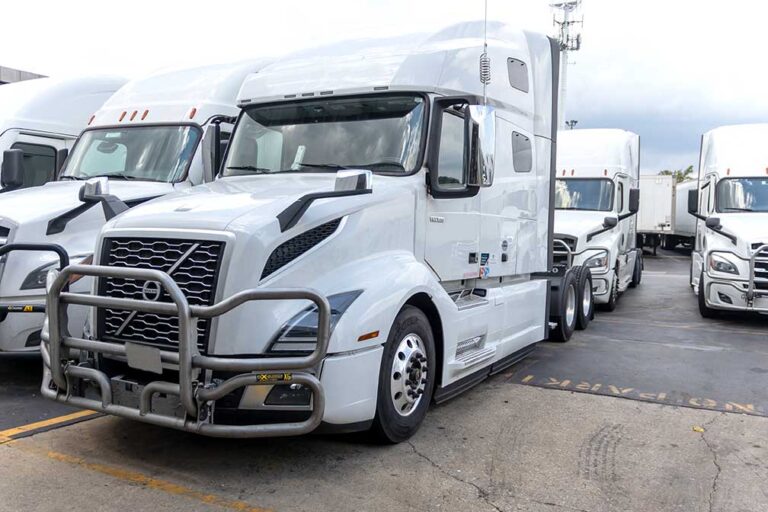Carriers continued to take delivery of Class 8 trucks at a strong pace in May, according to data received from Wards Intelligence. Orders for future delivery, however, are well behind current production levels.
Manufacturers reported U.S. sales of 18,778 trucks in May, up 700 trucks (3.9%) from April sales. Compared with May 2024, U.S. sales declined by 5.0%. For the year to date, reported sales of 87,438 are running behind the 2024 pace by nearly 8,000 units, declining 8.4% so far this year.
The money factor
While a number of factors can influence the market, the biggest is money.
“When carriers are making money, they buy trucks,” as Kenny Vieth, president and senior analyst for ACT Research, likes to say.
Judging from first-quarter financial reports submitted by publicly held carriers, they aren’t making much money.
Revenues have not kept pace with expenses, and low freight rates are the reason. A recent blog posting from ACT noted that weaker sales stem from “soft freight volumes, elevated inventories and carrier margins now at 15-year lows across much of the for-hire sector.”
Carriers are, for the most part, taking delivery of trucks ordered months ago, but economic uncertainty is holding them back from ordering more.
FTR Transportation Intelligence reports that preliminary North American Class 8 orders in May looked to be around 12,000 trucks. That number is “well below historical norms,” and “the weakest May showing since 2020,” according to a June 4 press release. It’s also down 47% from orders placed in May 2024.
“Tariff volatility and uncertainty over the economy and the truck freight market continue to disrupt the North American Class 8 truck and tractor market,” said Dan Moyer, senior analyst-commercial vehicles at FTR.
ACT Research reported similar preliminary order numbers at 13,000 units, noting a 45% year-over-year decline.
“Entering the weakest period seasonally for new business, Class 8 orders continued to decline in May, as weak fundamentals and broad uncertainty pressure demand,” said Carter Vieth, research analyst at ACT. “Unsurprisingly, tractor orders fell 43% year-over-year. Vocational truck orders fell 48% year-over-year.”
Vocational sales of Class 8 trucks used for dump, trash, concrete or other uses (rather than equipped with fifth wheels to pull trailers), had been on the rise. Funds available in the final year of President Joe Biden’s “Infrastructure Investment and Jobs Act” were credited with stimulating sales. The Trump administration, however, has curtailed spending for some projects, changing the financial picture for some buyers.
Emissions regulations up in the air
Truck manufacturers, which were dealing with build backlogs of nearly 12 months not long ago, are now looking at filling build slots in the third quarter of 2025, just a couple of months away. Order cancellations are up, too, as carriers reevaluate their equipment needs and make decisions to hold on to their current fleets a little longer.
In addition, the Environmental Protection Agency was set to enforce new heavy-duty truck emissions regulations beginning with model year 2027. To offset the cost of meeting the new requirements, manufacturers were expected to raise the price of new trucks by $30,000 or more. Because of this, OEMs were prepared for motor carriers to pre-buy, loading up on 2025 and 2026 models to avoid paying for the more expensive units coming in 2027.
However, the Trump administration has gutted some rules and announced a review of others — creating a state of confusion for truck buyers. Because of this, many potential buyers are waiting for clarification before committing to more truck buys.
And then there are tariffs
Even though Trump has delayed the implementation of — and revised — tariffs against products manufactured in Canada and Mexico, tariffs still loom large in truck buying decisions, as final decisions are yet to come.
A recent announcement by the government of Canada that they will impose a “digital services tax” (DST) on technology companies such as Amazon, Meta and Google, resulted in the U.S. terminating all trade discussions with the country.
Don’t forget that U.S. truck manufacturers have plants in Canada and Mexico. It’s difficult to predict how tariffs (once finally agreed upon) will impact new truck prices. Manufacturers might shift production to U.S. facilities to avoid tariffs, or they may wait for a final determination. In the meantime, buyers who are considering ordering new trucks may not be able to predict their final cost.
OEM reports for May
Individual OEMs reported a mixed bag of sales results for May. Freightliner, Peterbilt and Volvo reported lower year-over-year sales, but other manufacturers actually gained over last May.
Freightliner reported sales of 6,076 units, a decline of 7.3% from April sales and 10.6% fewer than what was sold in May 2024. For the year to date, Freightliner’s sales of 32,021 trucks trail last year’s pace by 8.1%.
International posted quite different results. The company reported U.S. sales of 2,024 in May — a gain of 53.9% over April’s 1,315 and 5.9% better than May 2024, when the company reported 1,911 sold. For the year to date, International has sold 9,207 Class 8 trucks, just 3.1% behind its 2024 pace after the first five months.
Kenworth reported U.S. sales of 3,267, up 7.5% from April’s 3,038 and up 13.6% from May 2024. Year to date, Kenworth has reported U.S. sales of 13,354, about 9.0% behind its 2024 pace. Peterbilt’s results weren’t quite as good, with 3,105 units sold in May, just 9 more than in April. Compared with May 2024, Peterbilt sales declined 4.9%.
Volvo’s reported 1,675 sold in May was an increase of 10.9% from April — but fell 28.2% behind U.S. sales a year ago in May 2024. For the year to date, the company is 2,804 trucks behind last year’s pace for a decline of 28.2%. Volvo’s sibling Mack, however, has seen gains across the board. May sales of 1,637 topped April sales by 8.8% and were 1.5% higher than sales last May. Year to date, Mack sales are running 8.2% ahead of last year.
Western Star continued its increased production with sales of 991 in May. While sales declined 6.4% from April, they were 6% better than May 2024. For the year to date, sales are up 9.8%.
As for market share, Freightliner’s 36.6% leads the way with Peterbilt at 15.7%, Kenworth at 15.5%, International at 10.5%, Volvo at 8.2%, Mack at 8.0% and Western Star at 5.5%.
New Class 8 sales are expected to remain weaker until freight rates improve and purchase costs become clearer.
Cliff Abbott is an experienced commercial vehicle driver and owner-operator who still holds a CDL in his home state of Alabama. In nearly 40 years in trucking, he’s been an instructor and trainer and has managed safety and recruiting operations for several carriers. Having never lost his love of the road, Cliff has written a book and hundreds of songs and has been writing for The Trucker for more than a decade.














